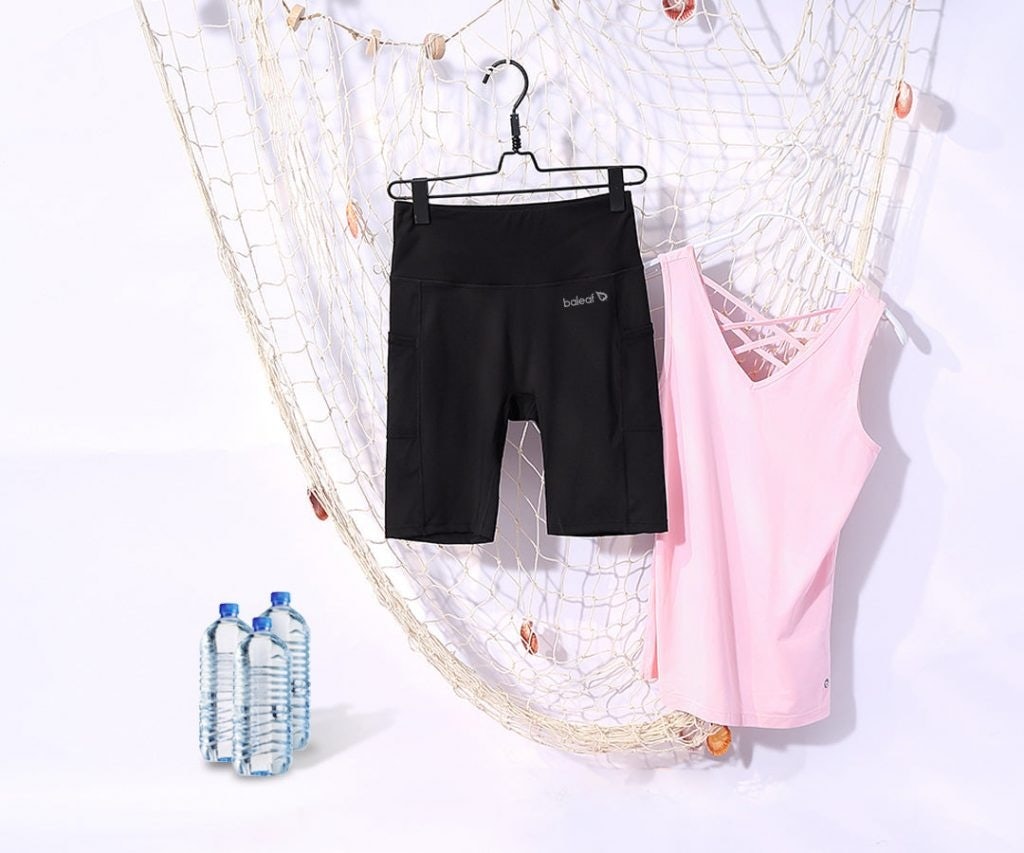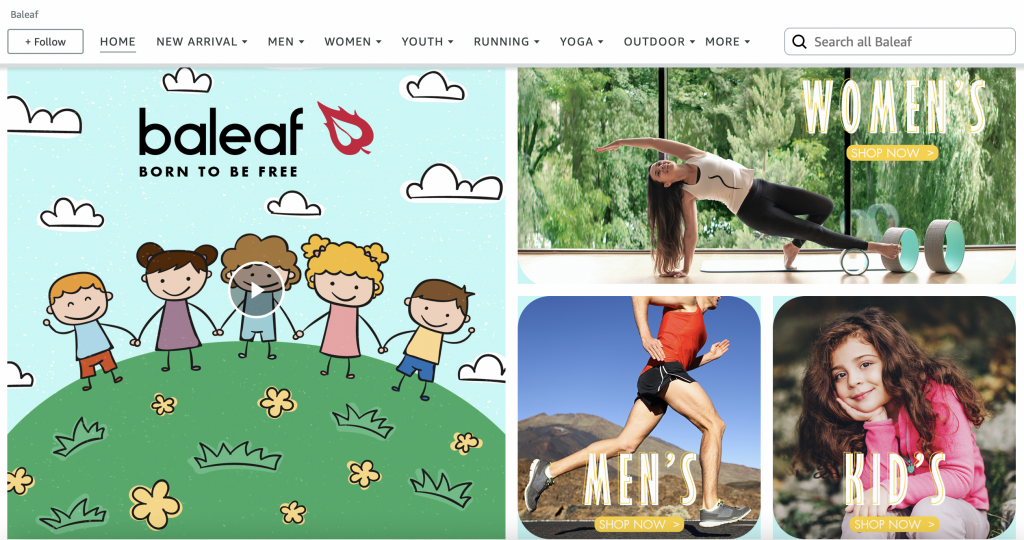The global sportswear retail market has reached new heights since the pandemic, recording $666.2 billion in 2021 with a 22 percent year-on-year increase, according to Euromonitor. The market research provider also predicts the sector will expand to $955.4 billion in 2026.
Amid the global popularity of at-home workouts over the past two years, Lululemon, a sportswear brand featuring colorful yoga lines, has stood out as an ace. Despite the market being largely occupied by big names such as Nike and Adidas, Lululemon’s rapid growth has made the global sportswear market, including the US, more promising. As such, venture capitalists have been searching for the next Lululemon.
In Amazon’s Best Sellers Rank in the yoga category, a Chinese athletic brand stays on top all year round. Given its outstanding sales performance and affordable prices, the brand named Baleaf is also dubbed as the “affordable Lululemon” by local media. What is the background of this export-oriented Chinese athleisure brand? And is it merely a cheaper alternative to Lululemon?
From product export to brand export#
At the end of last year, a piece of financing news drew the attention of the players in cross-border commerce. Junyi, a Xiamen-headquartered company, completed a $14.85 million (100 million yuan) Series A financing, which was led by the CICC Cultural Consumer Fund under CICC Capital and followed by Blue Lake Capital. According to local media 36kr, the company established in 2014 focuses on sportswear and gears, including five categories: yoga, running, outdoor, swimming and cycling. And Baleaf is the most well-known among the brands run by the company.
Following the trend of Chinese brands making their foray into the global market by launching on Amazon, Baleaf opened a store in the marketplace in 2014. At that time, Chinese players mainly focused on selling their products abroad. However, Junyi’s founder, Xu Muxuan, decided to engage in the fast-growing sector with a vision to create a “cross-border e-commerce brand.” In an interview, Xu shared that the company adopted a model featuring independent R&D and outsourced production. Since 2018, the company has invested “a lot of resources to build its supply chain empowered by a digital system,” allowing it to develop its functional and comfortable best-sellers while maintaining high production capacity.

When it comes to Baleaf’s target market, the US cannot be neglected, whether it's for product export or brand export. As early as 2019, the US achieved a fitness population penetration rate of 20.3 percent, indicating a large sportswear market with great potential. According to Statista, the US sports apparel market was valued at roughly $105.1 billion in 2020 and is expected to reach $113.4 billion in 2021. In addition, Similarweb statistics show that 87.84 percent of the recent traffic on Baleaf’s official website comes from the US, implying how important the market is to the brand.
Still, a huge market means fierce competition. Baleaf is called the “affordable version of Lululemon” partly because its most valued market, the US, is equally important for Lululemon. According to Lululemon’s 2022 Q3 financial report, the US market contributed $982 million, or 67.7 percent, to the brand’s total revenue in the third quarter, representing a 26.6 percent year-on-year increase. Although targeting the same market, is Baleaf really a vertical rival to Lululemon?
A unique brand positioning#
Firstly, in terms of nature, Baleaf is a cross-border e-commerce player focusing on online channels including its stand-alone website and Amazon. In contrast, Lululemon rose from a physical store and expanded with its two important tools: offline retail and community building. Its fast-growing online sales in recent years can only be regarded as the icing on the cake.
Secondly, in terms of categories, Baleaf covers a wide range of sportswear as well as niche outdoor gear, thus appealing to a large consumer base. Notably, the brand declares on its official website that its products are highly adaptable, not limited to a certain sports scenario but universal to golf, mountaineering, fishing, beach volleyball and other scenarios. That has further expanded the brand’s consumer base and become the main characteristic that distinguishes Baleaf from Lululemon and other athleisure brands.
Last but not the least, Baleaf differs from Lululemon in brand building and marketing. Lululemon would not have gotten popular without its strong community building rooted in wellness, inclusivity, and women empowerment. Deeply connected to yoga scenarios, Lululemon has become a symbol of community identity.
In contrast, Baleaf still relies on its pricing strategy which is common among Chinese brands. According to Similarweb, more than 90 percent of the social media traffic on Baleaf’s official website comes from a single platform, Facebook. The brand has only 24,000 followers on the social platform and mainly posts content such as buyers’ snapshots, new launches, and discounts. Such performance certainly cannot stand out in the US market where social media operations are given great emphasis. Judging from its target market and price, Baleaf can literally be regarded as a cheaper version of Lululemon; however, it still has a long way to go in terms of brand building.
How to survive in the highly competitive global market#
Tony Boffa, the founder of Bilzar, an Amazon Seller Central Service Partner, followed Baleaf through Amazon. “Baleaf’s yoga shorts always sell the best in their segment, with more than 40,000 pieces sold monthly in summer.” However, last year, he noticed that when winter was approaching, Baleaf lowered the price of its hot items from $25 to $20 on Amazon. “Why did they do this? Obviously, they were cutting the price to maintain No. 1 sales in the off-season.”

Growing with the trend of exporting products via Amazon, Baleaf undoubtedly still needs to make its prices more affordable to achieve decent sales. However, the reason why the brand can survive in the global market is far beyond that.
Baleaf began to operate its official website just as Chinese cross-border e-commerce brands were emerging. According to the Seller Center, the brand’s official website was registered in the US in November 2015. With the majority of people only wearing 20 percent of their wardrobe regularly, Baleaf describes itself as a solution provider to this problem and makes sustainability a key part of its narrative.
On its official website, Baleaf provides a complete brand story by raising the practical wardrobe problem facing consumers, listing specific sustainability measures practiced in its supply chain, and reflecting on how to improve product adaptability from the perspective of sustainability. In this way, Baleaf starts from multiple dimensions to better reach environmentally concerned consumers.
In addition, like Lululemon, Baleaf also has a blog on its official website, regularly inviting athletic professionals to write articles and share sports experiences and useful information with consumers to drive traffic. However, it needs to be noted that the DTC channel still heavily relies on social media marketing — continuous traffic cannot be driven by affordable prices and the occasional blog post alone.
